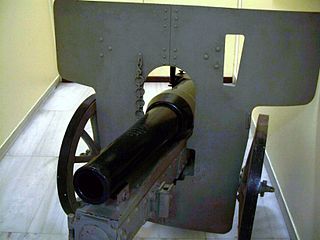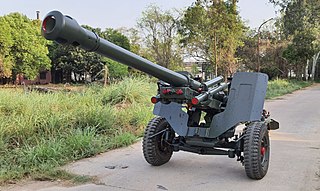
The howitzer is an artillery weapon that falls between cannon and a mortar. With their long-range capabilities, howitzers can be used to great effect in a battery formation with other artillery pieces, such as long-barreled guns, mortars, and rocket artillery.

Mountain guns are artillery pieces designed for use in mountain warfare and areas where usual wheeled transport is not possible. They are generally capable of being taken apart to make smaller loads for transport by horses, humans, mules, tractors, or trucks. As such, they are sometimes called "pack guns" or "pack howitzers". During the American Civil War these small portable guns were widely used and were called "mountain howitzers".

The G5 is a South African towed howitzer of 155 mm calibre developed in South Africa by Denel Land Systems. The G5 design was based on the Canadian GC-45 155mm gun which was highly modified to suit southern African conditions.

The M777 howitzer is a British towed 155 mm artillery piece in the howitzer class. It is used by the ground forces of Australia, Canada, Colombia, India, Saudi Arabia, Ukraine, and the United States. It was first used in combat during the War in Afghanistan.

The L118 light gun is a 105 mm towed howitzer. It was originally designed and produced in the United Kingdom for the British Army in the 1970s. It has since been widely exported. The L119 and the United States Army's M119 are variants that use a different type of ammunition.

Ordnance, QF 3.7-inch howitzer is a mountain gun, used by British and Commonwealth armies in the First and Second World Wars, and between the wars.

The OTO-Melara Mod 56 is an Italian-made 105 mm pack howitzer built and developed by OTO Melara. It fires the standard US type M1 ammunition.
In India, the Armament Research & Development Establishment (ARDE) is a laboratory of the Defence Research and Development Organisation (DRDO). Located in Pune, it is the main DRDO lab involved in the development of conventional armaments.

The 75mm Pack Howitzer M1 was a pack howitzer artillery piece used by the United States. Designed to be moved across difficult terrain, gun and carriage could be broken down into several pieces to be carried by pack animals.

The Regiment of Artillery is a combat/fighting arm of the Indian Army, which provides massive firepower during all ground operations of the Indian Army. It is a successor to the Royal Indian Artillery (RIA) of British Indian Army, which itself traces its origins to the formation of Bombay Artillery in 1827.

The Advanced Towed Artillery Gun System (ATAGS) is a towed 155 mm/52 calibre howitzer that is being developed for the Indian Army by Armament Research and Development Establishment (ARDE), Tata Advanced Systems and Kalyani Strategic Systems. Bharat Forge, Tata Power SED and Advanced Weapons and Equipment India are manufacturing partners.

The 105 mm Indian field gun is a towed howitzer developed in India and extensively used in the Indian Army.

Dhanush (bow) is a 155 mm towed howitzer manufactured by Advanced Weapons and Equipment India Limited, previously a part of Ordnance Factory Board. The gun was approved for service in 2019 and has been inducted into the Indian Army. The Dhanush project was started by OFB to replace the older 105 mm Indian Field Gun, 105 mm Light Field Gun and the Russian 122 mm guns with a modern 155 mm artillery gun. The Dhanush gun is manufactured by the OFB at its Gun Carriage Factory Jabalpur.
The Field Artillery Rationalisation Plan is a procurement-cum-development plan of the Indian Army. The programme was drafted in 1999 in the aftermath of the Kargil war, emboldened by the success of the 155mm Bofors guns in its inventory. The programme was slated to replace the weapons of 169 artillery regiments with modern weapon systems, predominantly of 155mm calibre. The procurement involves direct import, manufacture under license, as well as inhouse development of artillery weapon systems.
22 Medium Regiment (Sittang and Yenangyaung) is part of the Regiment of Artillery of the Indian Army. It was raised in 1920 as 8 Pack Artillery Brigade.
23 Field Regiment is part of the Regiment of Artillery of the Indian Army.
97 Field Regiment is part of the Regiment of Artillery of the Indian Army.
90 Field Regiment is part of the Regiment of Artillery of the Indian Army.
53 Medium Regiment is part of the Regiment of Artillery of the Indian Army.













